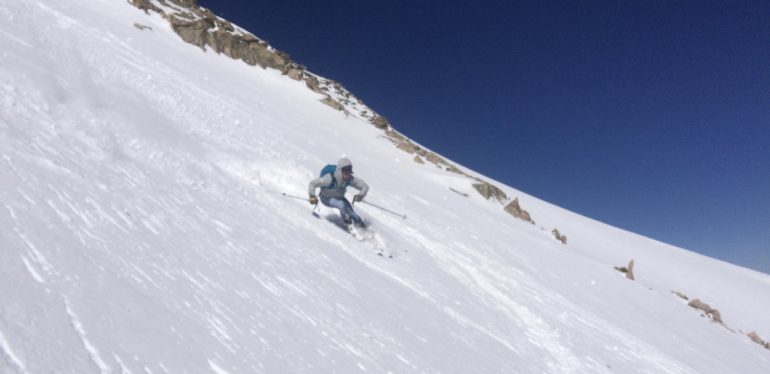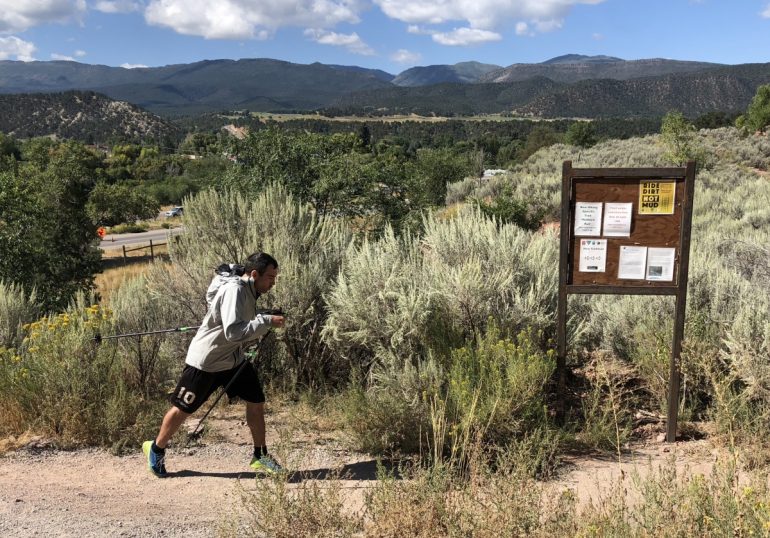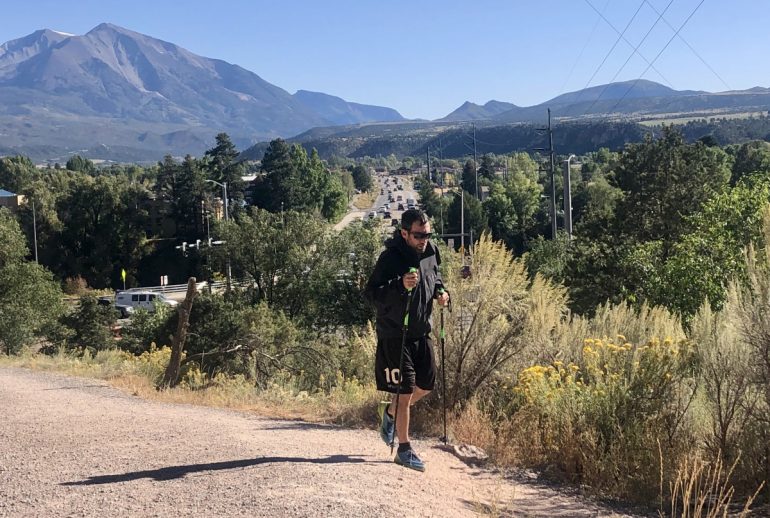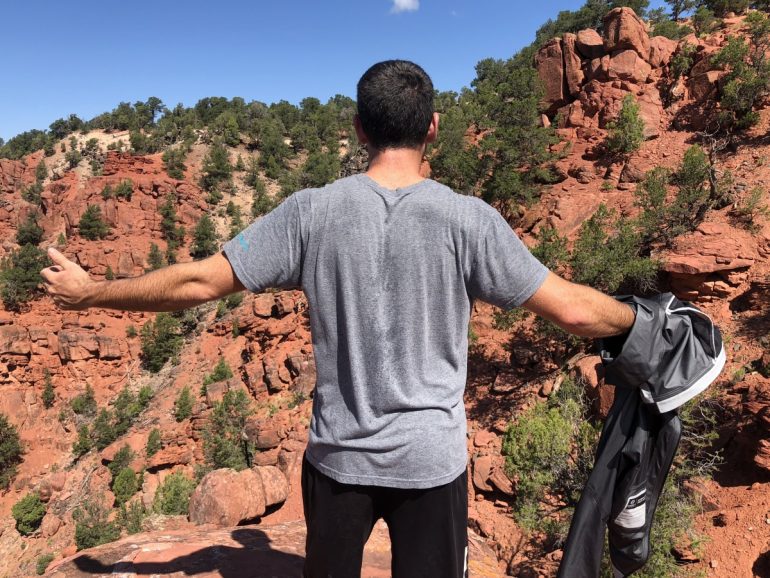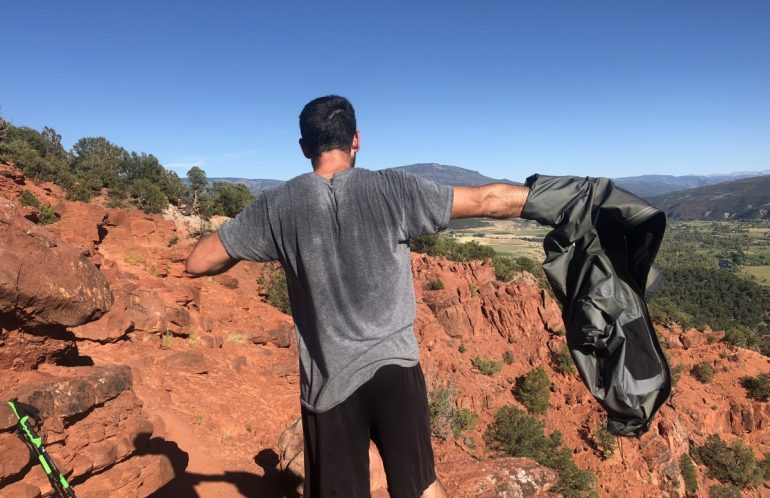For breathability, we employ the reputable sweat test
After The North Face’s retail launch of their new FutureLight fabric, I felt it was time for a test with some real science behind it (check out the review). Afterall, there are dozens of gear review websites with testing laboratories that I can only assume are filled with all the latest and greatest gadgetry for non-biased results (BTW: does anyone know where I can calibrate my arm for flex testing skis?). Since the WildSnow DIY waterproof tester is still a pile of PVC pipe and bailing wire in Lou’s garage, I contacted a third party lab to do some truly unbiased testing.
But after receiving the lab’s astronomical price quote, I decided to leave that to the professionals and go back to testing gear the only way I know how: put the jacket on, thank The North Face for their on-going support of WildSnow, and run through the mountains while carefully and systematically documenting the way the gear makes me feel.
Beginning in November 2018, I’ve logged an entire season in FutureLight. From standing on the top of Colorado’s windiest fourteeners, to baking on the flanks of spring Pacific Northwest volcanoes, and even getting poured on for several aborted ski missions, FutureLight kept me dry. The most significant observable feature through a season of testing was how little I thought about whether the jacket was on or off. But how would it hold up in warmer temps, when breathability was at its most crucial?
Test design
All hope of “science” was not necessarily lost — I devised a test that could give the reader some real insight into the uniqueness of this new garment. After a season spent skiing in the new FutureLight jacket, I figured a summer running test was in order to prove the actual breathability. The test track would be up the infamous Red Hill, whose rust-colored bulk can always be seen looming behind the town of Carbondale. I planned and conceptualized the study at the beginning of the summer, thinking it would be simple to slide this test into my intended summer running regimen in preparation for the ski season. However, I awoke a recent morning to snow in the mountains and a calendar date that had mysteriously slipped to the middle of October, and I realized that it was high time for my first fall training mission.
The actual Test
For the Red Hill running study to be completely objective, I would leave no stone unturned in my quest for data. For a control, I decided on an older model Gore-Tex Pro Shell. Long the industry standard, the backing fabric and brand name have been left anonymous for fear of legal repercussions. For the test piece I chose the Summit L5 LT FutureLight jacket.
I also took into account every variable to ensure 100% consistency — or at least document the differences for the ever-discerning WildSnow reader. I watched the weather like a hawk for the conditions to line up just right on two subsequent days. Finally, I saw my weather window. The time had come to wheeze while running uphill wearing a shell.
Variables kept 100% consistent
Testing Track: 2.5 miles, 850 vertical feet
Control Wardrobe: Shoes: Dynafit Feline UP trail runners, Shorts: Technical elite Ultimate Frisbee brand, Base Layer: Grey Dynafit 100% cotton t-shirt for maximum sweat ring visibility
Poles: Carbon Fischer Transalp, slightly bent on left pole
Variables up for some interpretation
Pre-hydration
FutureLight: 1 liter of coffee, 0 liters of water
Control: 1.3 liters of coffee, 0 liters of water
Pre-dehydration
FutureLight: .8 liters of wine the night before
Control: 1 liter of Eddy Line Brand IPA the night before
Temperature
FutureLight: 66 Degrees
Control: 58 degrees
Humidity
FutureLight: 28%
Control: 22%
Test Garment Color
FutureLight: very light gray
Control: black
Results Time (minutes)
FutureLight: 19.02
Control: 18.45
Ok, if you have made it this far into the article, you know that this is not the most “objective” or “lab tested” review of FutureLight on the web. This is just one out-of-shape reviewer’s take on a garment while he reflects with bewilderment on where a summer went. There were times I had even considered bringing a spray bottle to make it a full an obvious joke at the top. But, in the end, there was at least some merit to the test.
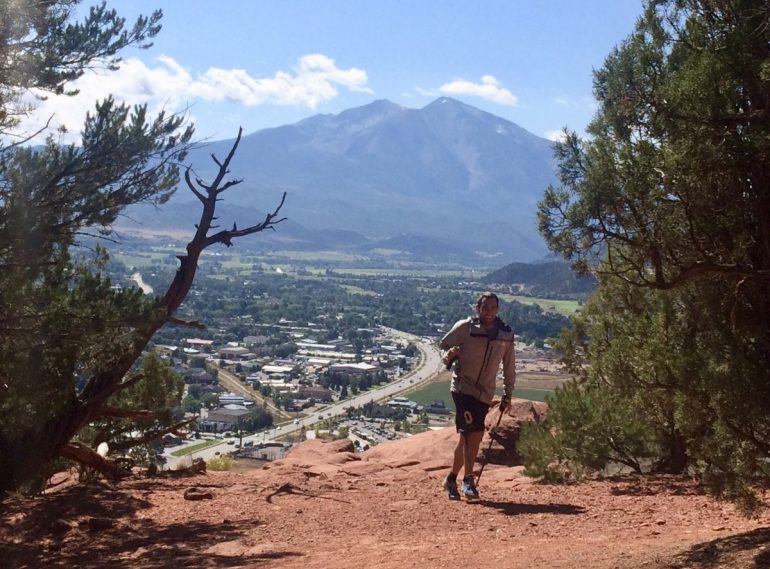
Testing FutureLight breathability on the Red Hill escalator.
The results
During the FutureLight testing, I delighted in not actually feeling the jacket while running (but maybe I was distracted by the effort to breathe and maintain uphill momentum). When taking the jacket off, I had light but visible sweat stains in the armpits, shoulders and back of my t-shirt.
However, when pulling off my jacket on the day of control testing, I was blown away (and my photographer disgusted) at the noticeable difference in sweat. It showed up in dark dense pools on the grey cotton t-shirt. The sweat shown in these photos is 100% real even if the measurements of hydration and actual ascent time are significantly exaggerated.
Conclusion (and reality check)
When all scientific measurements and calculations have been stripped away, we merely have our own opinions, emotions, and personal taste for making, what is, all joking aside, a critical decision about layering in the mountains. In the touchy feeling portion of the this review the literal observation made for both touching and feeling are noticeable. FutureLight is soft enough to run in without feeling it scratch on my bare arms, while being stretchy and silent enough that you don’t think about it. When suffering uphill on my first trail run of the off season and my first time running with poles since high school, it certainly removed the distracting level of discomfort experienced while running uphill in the control jacket.
Referring back to the months of winter testing, it is important to note that this is an active piece. When starting a tour thousands of feet below a summit in warmer temps, a base layer would be all I needed to start the day off moving. As I approached windier ridgelines and summits, the FutureLight shell came on once and then I would not so much as adjust a zipper for the rest of the climb. Although I never needed a burlier jacket while moving fast in high places against agonizing winds, the external air permeability is noticeable. This would not be my number one shell choice for hunkering down in a gusty wet storm for the long shiver bivy. There are some beefier FutureLight jackets that could work better in these conditions at the cost of a bit of extra weight. In spite of my personal fitness level jokes, I consider efficiency in the mountains to be the most important feature of every piece of gear.
For those crafty consumers that notice this was a sweat test and not a waterproof test, I can promise a very sad looking timelapse video of me getting poured on as soon as it rains in Colorado again. Until that time, as the nights get colder and as the time for cross training ticks away, the L5 LT FutureLight continues to offer amazing breathability and temperature control for the aspiring fast and light mountain athlete.
Doug Stenclik is an avid skimo racer and ski mountaineer who lives for sharing the amazing sports of ski touring and splitboarding. Since his first time on skins he was hooked and the obsession has taken him all over the United States and the world pursuing the human powered ski turn. He founded Cripple Creek Backcountry in 2012 and took over the Colorado Ski Mountaineering Race Cup in 2014 to spread knowledge and the love of the sport. In 2019 he took a step back from the ski shop and race promoter life to become a publishing partner with WildSnow.

